
Jeans are a staple in most of our wardrobes and need no introduction but we all have different tastes in jeans. And there is something that differentiates the many different types of jeans out there other than the plain dark indigo colored raw jeans – the washes or the finishes that the denim undergoes during the manufacturing of jeans.
The washes and other surface treatments on the surface of denim fabric enhance the beauty and the popularity of jeans. They produce eye-catching effects like color fading, contouring, spotting, marbling and creates a lived-in faded look which we all cherish and add more value to the product.
Before the jeans undergo the washes there maybe some pre-treatment processes involved. But when denim is used without these pretreatments it is called Raw denim or Dry Denim and it has its own value.
Pretreatment is the process by which all the oil or chemical-based impurities added during the manufacture of fabric is removed. It helps to avoid streaking, color loss, and stiffness. Desizing removes the sizing agents applied to strengthen the yarn during weaving. The product is now treated with anti-crease agents to reduce the risk of creasing. When denim is washed just once like this, it is called one-wash.
When customers demand a lived-in look with an authentic-looking fade for their jeans, and a soft texture to the rough and tough denim, it has to go in for a more special “wash” and other surface treatments.
Different types of Jeans Washes
There are several kinds of finishing processes practiced in the denim industry. Here are the most important of them
Acid wash
This method results in light and dark contrast colors on the denim surface.
This is a process in which pumice stones are soaked in a solution of chlorine bleach, or potassium permanganate for a specified time. The solution will be emptied and the fabrics are tumbled dry with the stones to achieve a very strong irregularly colored/bleached indigo coloring with a high contrast effect/splotchy marble-like look.
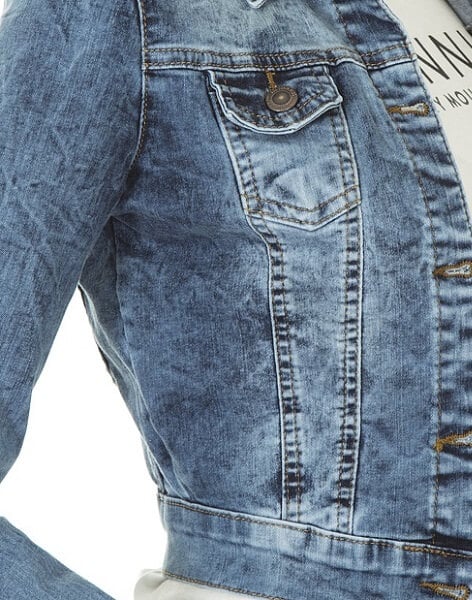
Though the acid wash is cheap and easy to do, it also has many drawbacks like the wide variation in effect for repeated runs and greater damage to the strength of the denim. This wash may cause holes and thread breakage
Other names are Moon wash, ice wash, Marble wash.
Atari /Whiskering
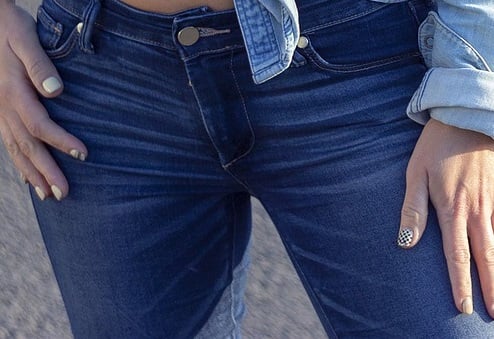
This refers to a number of surface treatments that result in horizontal lines (whiskers) across jeans that look like creases. Other than whiskers, another term called train tracks is used for a fading along the outer seam of a pair of jeans- this looks like train tracks, hence it is called rail tracks. Many methods including use of laser and hand abrasion with rodes are used to make these lines.
Bleach wash
Bleach washing is used for that faded effect – it gives a light blue shade to denim.
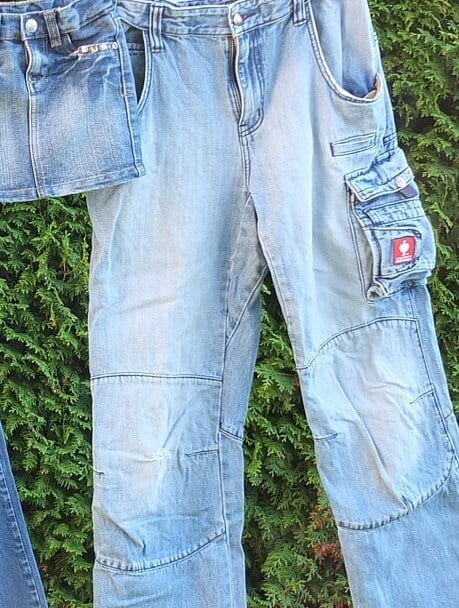
During the bleach wash, strong oxidizing agents like sodium hypochlorite, calcium hypochlorite, hydrogen peroxide, and potassium permanganate are used to produce a very strong bleaching effect. The selection of the chemical used depends on the dye and the desired effect to be produced.
This wash is a tedious process and all the chemicals must be thoroughly removed from the fabric to avoid further damages, bad smell, skin irritation, etc. The bleach wash can also damage the cotton cellulose and negatively affect the strength of the fabric.
Dyeing & Tinting
Jeans have a characteristic Indigo blue color and the dyeing is done at the yarn stage, using a complicated dyeing process. As fashion dictates, the preferred color for jeans changes – and the dyeing is decided accordingly. Red jeans, green jeans, yellow jeans – we have seen it all.
Tinting is done when the color of the denim has to be deepened to give it a different or vintage look. This is done after the washes are finished. Surface dyes are used for tinting. Overdyeing is done to give a particular tint – this done over an already dyed denim. A tint appears over the dye.
Sulphur dyeing is a particular type of dyeing in which a grey tint is achieved along with the indigo dye. Cast refers to an additional tint added to the existing indigo blue color – a red cast or blue cast or green cast is given to the blue to give it a depth.
Enzyme wash/ Cellulase Wash
Enzyme wash is a great method to give a faded look to the garment without damaging it. In fact, it is said to be the most environmentally friendly of all jean washes. The wash also requires less investment.
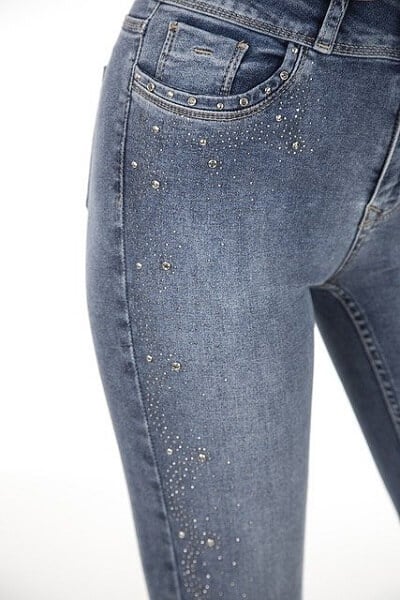
The enzyme is a protein obtained from bacteria and fungi. These enzymes work on cellulose. Denim, being a cotton fabric is made of cellulose. The process is considered to be eco-friendly as the enzymes are biodegradable.
The most common enzymes used in the industry are alpha-amylases, proteases, catalases, and cellulases. They are available in three categories namely neutral, acidic and hybrid.
Acid cellulose gives faster results among the three, but it affects the strength and indigo color of the jeans and is also prone to back staining. The neutral cellulose on the other hand has a less adverse effect on the strength of the fabric. Also, it gives better salt and pepper effect and the fabric is prone to less back staining.
Hybrid enzymes are a combination of acid and neutral enzymes; this is known to give better results in a faster time frame.
After the enzyme wash, it is important to do a clean-up process to kill or deactivate all the enzymes. It is achieved by increasing the temperature, upsetting the pH value, etc. During enzyme wash, it is very crucial to control the parameters of the wash cycle, like the pH value, temperature and duration. Any of these parameters going wrong can produce inaccurate results.
Hand abrasion methods
This method uses different abrasive actions to create the faded look in a selective place. Pumice stones, sandpaper, etc are used.
Resin treatments
Special resins are coated on denim to give it a look of natural looking wrinkles and creases.
Rinse wash
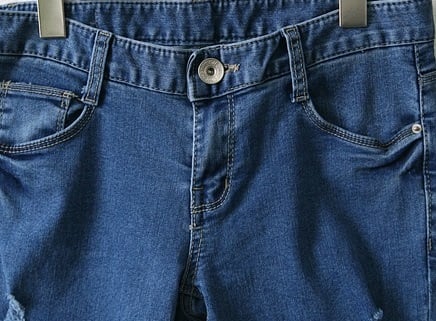
It is the most basic wash where the fabric is rinsed in plain water in drum washing machines to remove impurities like dust and makes it soft and wearable. This wash removes the least amount of color from denim.
River wash
In this wash, the denim is washed in a machine with pumice stones and then treated with enzymes.
Sanding methods
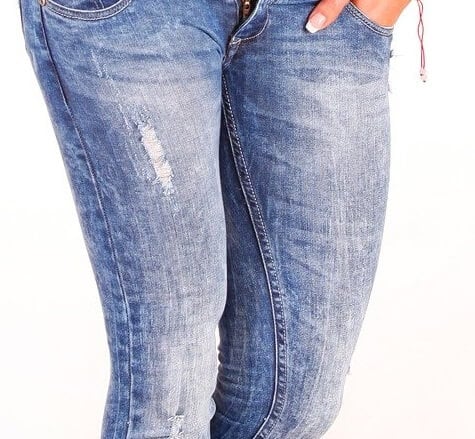
In Sandblasting method, sand is blasted onto the denim surface with the help of high-pressure sprayers to create a distressed look. Blast methods create a very faded look. Microsanding uses special rollers covered with abrasive paper.
Snow wash
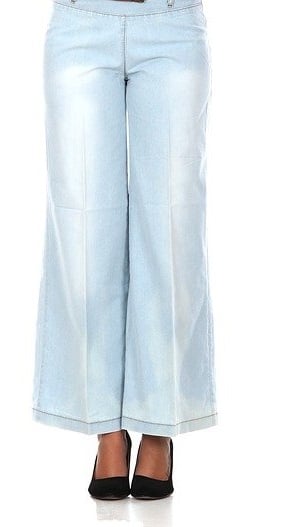
This is an intense form of Acid wash in which the denim is faded to an almost white color.
Stonewash
The basic process for getting a faded look on denim jeans is the stonewash process. The pumice stones or volcanic stones are used in a drum washing machine. The newly dyed denim which is loaded into the machine gets abraded by the stones. The outer layer of the indigo-dyed yarn gets partially removed to show the undyed inside portion to get the washed-down look.
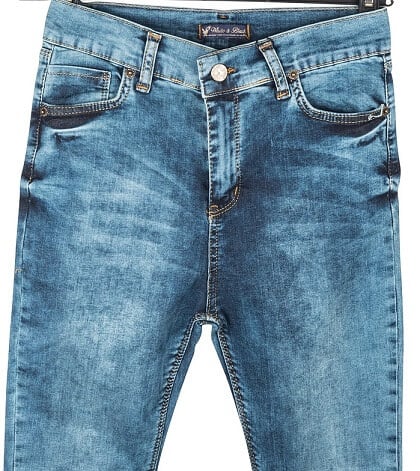
Getting the washed-down look depends on many factors like the stone size, stone to fabric ratio, liquor ratio, the weight of the garment loaded, and duration of the treatment. Most important among these is the stone size
Different sized stones are used to produce different kinds of wash namely sand wash, micro wash, micro sand wash, and golf ball wash. The common size of the stones used for a normal denim wash may vary from 3 to 6cm in diameter. Smaller stones are used to produce finer denim jeans. The stone wash process is expensive as it requires huge capital investment.
Vintage wash
In this, Denim will have gone through a lot of destressing/ deconstructing/ destroying processes to achieve a vintage look.
You can re-create a lot of these effects at home with your simple jeans and make them look exceptional. Check out this post for tips – How to distress your jeans
Related posts : 20 different types of denim fabric; Embroidering on jeans; Different types of Jeans; History of jeans; Best jeans brands; Repair jeans; Fix holes on jeans; Replace buttons on jeans; How to embellish jeans; How to make ripped jeans ; Different characteristic parts of jeans

I have a pair of jeans that the color comes off and on to a couch or chair fabric that I am sitting on. Is there anything I can do to stop this transfer?
Yes you can through with color fixing treatment, Secondly when ever you buy pair of jeans you should smell it, if you feel smell chemical from them then avoid to buy them.